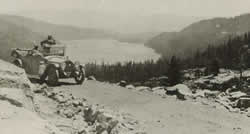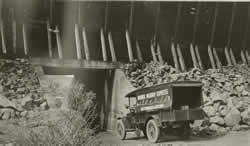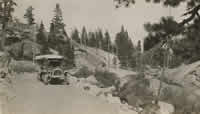
As America entered the 20th Century, it was an amazing time. Electricity, the telephone, labor saving devices, better health and sanitation, and industrialization were changing lives. In 1900 America had become the richest country in the world and a world power. Automobiles and trucks would change lives even more.
America entered the 20th Century, it was an amazing time. Electricity, the telephone, labor saving devices, better health and sanitation, and industrialization were changing lives. In 1900 America had become the richest country in the world and a world power. Automobiles and trucks would change lives even more.
With the automobile people suddenly had more freedom. They could travel and that's what they wanted to do. So a movement arose to join together existing stretches of roads into a transcontinental highway. No longer would people be limited to railroad routes. They could go and see what they had only seen in pictures or heard about.
In 1913 the Lincoln Highway was born, the first national commemoration of President Lincoln. With the Lincoln Highway came guide books and road standards. Now people could travel at uninterrupted incredible speed across the country. The design of  the highway specified that automobiles should be able to travel at an average of 35 MPH and trucks at an average10 MPH. This was a time when California speed limits were 35 MPH in open country, 20 MPH in residen
the highway specified that automobiles should be able to travel at an average of 35 MPH and trucks at an average10 MPH. This was a time when California speed limits were 35 MPH in open country, 20 MPH in residen tial areas, and 15 MPH at intersections.
tial areas, and 15 MPH at intersections.
And travel people did. Where there had only been 150 transcontinental trips in 1913, by 1923 there were more than 20,000. Where it used to take 60 days to drive across country, in 1913 "20 days is an easy drive for anyone."
Top above: map of the transcontinental route. Top right: Lincoln Highway on Donner Summit with Donner Lake in the background. Right above: approaching Donner Summit on the Lincoln Highway. Left above: going into the 1914 underpass for the transcontiental railroad at Donner Summit. The structure on top is part of the many miles of snowsheds protecting the tracks from the 40 feet of average Donner Summit snowfall. See our snowsheds page.
Advice Traveling the Lincoln Highway, 1913
The through trip can be made from new York to San Francisco at any time between June 1st and November 1st. The passes in the Sierras do not usually open in spring much before June 1st and are likely to be closed by snow any time after November 1st.
It is wise for the transcontinental motorist to take as a precept the statement that when it rains in Iowa, Nebraska or Utah and he has a dirt stretch ahead of him the thing to do is to stop and not attempt to continue the journey until the rainy spell is over, and the roads have had a day or two to dry up.
Advice to "autoists" for "transcontinentaling" on the Lincoln Highway
Don't wait until your gasoline is almost gone before filling up. There might be a delay, or it might not be obtainable at the next point your figured on.
Don't allow your canteen… to be other than full of fresh water.
Don't carry loaded firearms in the car.
Don't forget the colored goggles [sunglasses].t
Don't forget the camphor ice. The dry air of the west will crack your lips and fingers without it.
Don't ford water without first wading through it.
Don't drink alkali water.
Don't wear new shoes.
Build a sagebrush fire to summon help
in case of trouble.
Equipment to take for highway travel, 1913: chains, shovel, axe, jacks, tires and inner tubes, and a set of tools.

